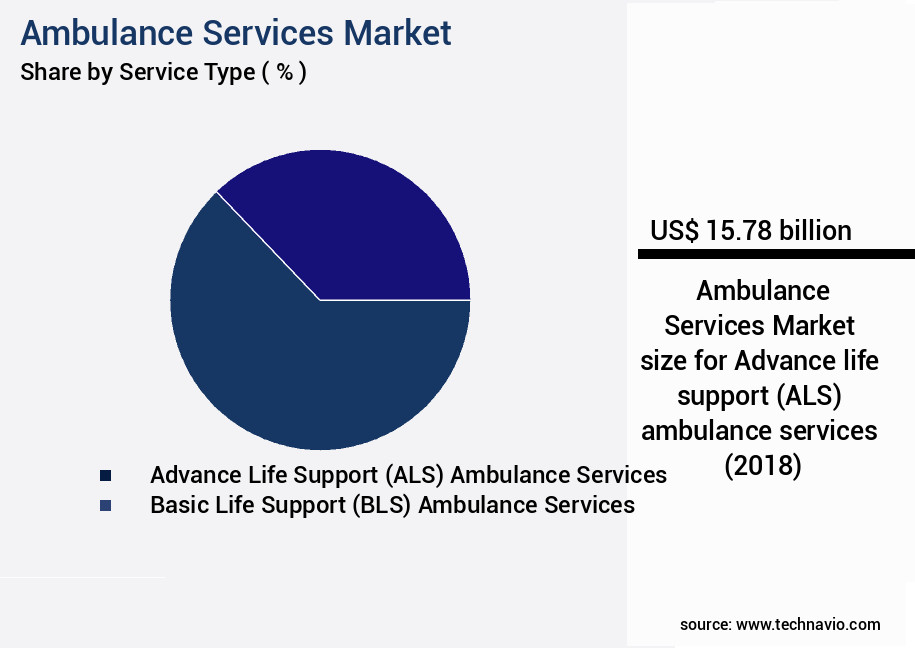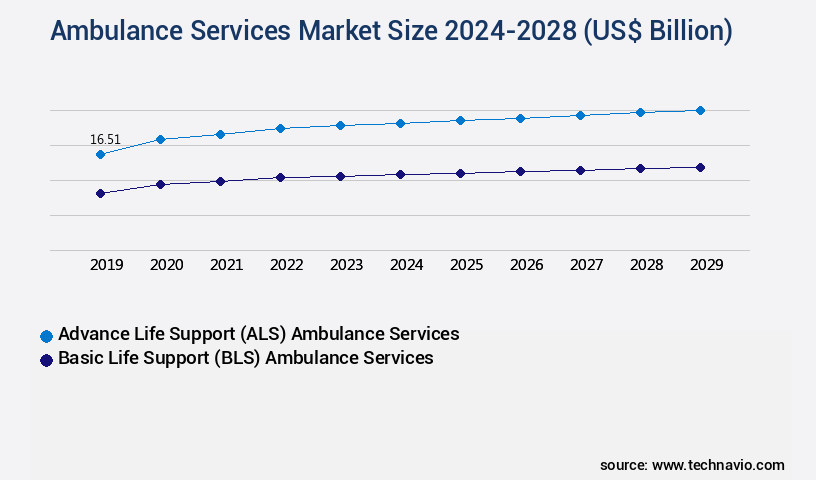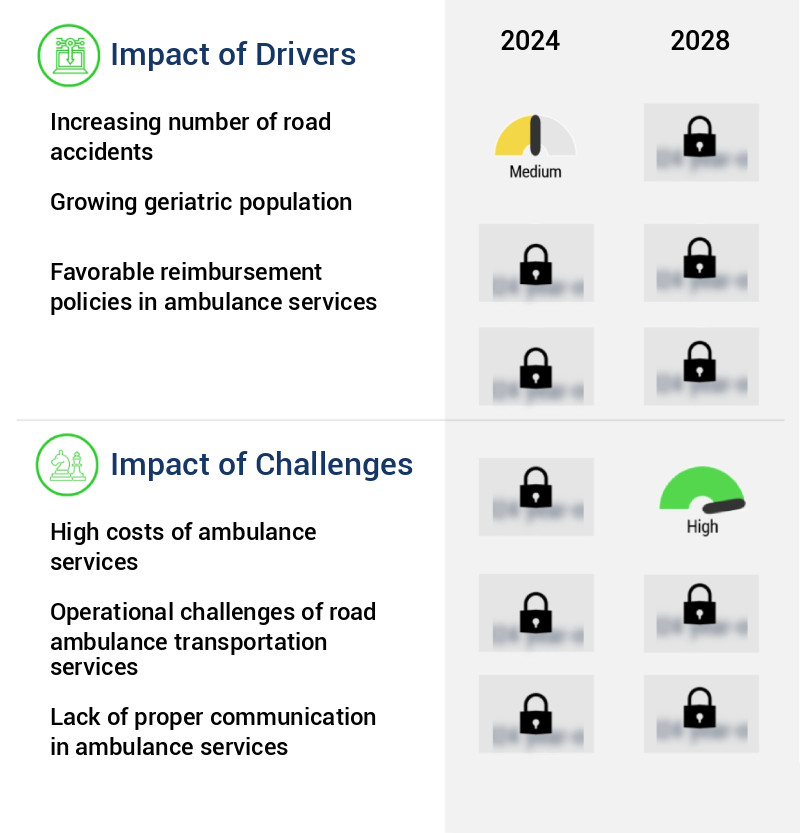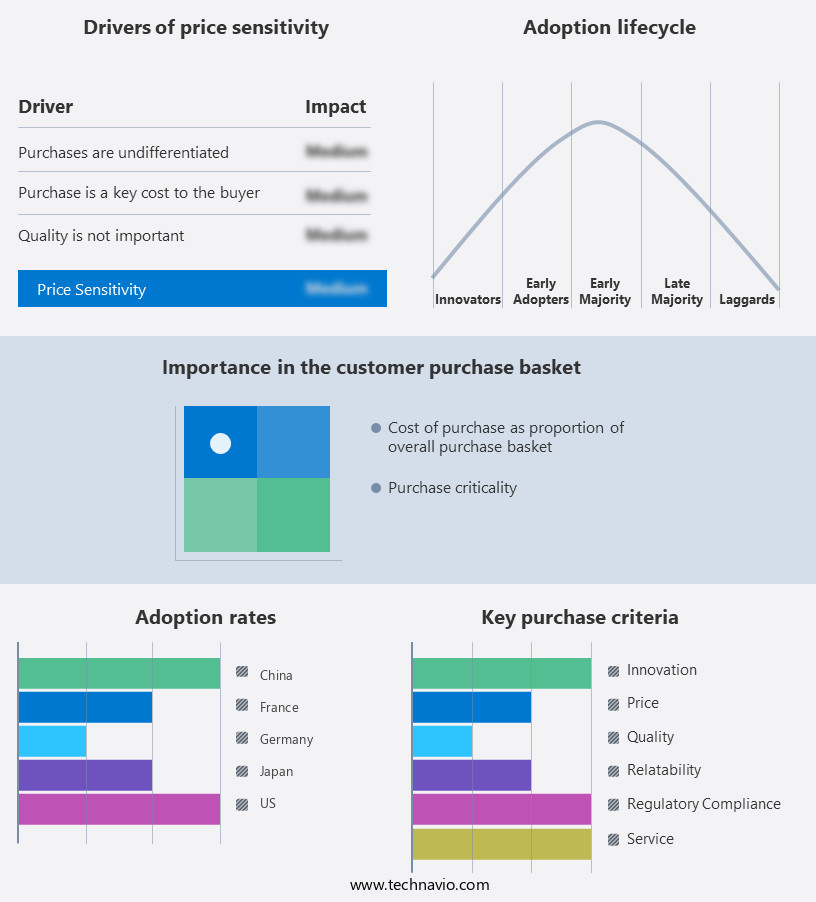Ambulance Services Market Size 2024-2028
The ambulance services market size is forecast to increase by USD 13.75 billion, at a CAGR of 6.79% between 2023 and 2028.
Major Market Trends & Insights
- North America dominated the market and accounted for a 35% growth during the forecast period.
- By the Service Type - Advance life support (ALS) ambulance services segment was valued at USD 15.78 billion in 2022
- By the Type - Emergency segment accounted for the largest market revenue share in 2022
Market Size & Forecast
- Market Opportunities: USD 96.05 billion
- Market Future Opportunities: USD 13747.30 billion
- CAGR : 6.79%
- North America: Largest market in 2022
Market Summary
- The market is witnessing significant advancements, driven by the increasing prevalence of chronic diseases and the growing recognition of the importance of timely medical intervention. One notable trend is the increasing adoption of air ambulance services, particularly in developing countries. This shift can be attributed to factors such as the expanding healthcare infrastructure and the rising disposable income of the population. In contrast, ground ambulance services continue to dominate the market, accounting for over 80% of the total market share.
- Despite these positive developments, the high costs associated with ambulance services remain a significant challenge. For instance, the average cost of an ambulance ride in the US can range from USD300 to USD3,000 or more, depending on the distance traveled and the level of medical care required. This financial burden can deter individuals from seeking necessary medical attention, leading to potentially life-threatening consequences. In conclusion, the market is undergoing continuous transformation, with a focus on improving accessibility, affordability, and the overall quality of care. By staying informed of these trends and developments, businesses can effectively cater to the evolving needs of their customers and remain competitive in this dynamic industry.
What will be the Size of the Ambulance Services Market during the forecast period?

Explore market size, adoption trends, and growth potential for ambulance services market Request Free Sample
- The market is a dynamic and complex ecosystem, characterized by ongoing advancements in technology and regulatory requirements. According to industry estimates, the global market for ambulance services is projected to reach USD 879 billion by 2025, growing from 2020. This expansion is driven by several factors, including the increasing prevalence of chronic diseases, growing emphasis on prehospital care quality, and the integration of advanced technologies. For instance, the adoption of GPS tracking systems, mobile data terminals, and predictive modeling techniques has significantly improved operational efficiency gains and response time analysis. Furthermore, the implementation of infection control protocols, staff competency assessment, and community health needs assessment have become essential components of ambulance services to ensure the highest level of patient care.
- Despite these advancements, ambulance services continue to face challenges, such as hospital transfer times, fuel efficiency metrics, and cost optimization strategies, necessitating ongoing quality improvement initiatives and risk management strategies.
How is this Ambulance Services Industry segmented?
The ambulance services industry research report provides comprehensive data (region-wise segment analysis), with forecasts and estimates in "USD billion" for the period 2024-2028, as well as historical data from 2018-2022 for the following segments.
- Service Type
- Advance life support (ALS) ambulance services
- Basic life support (BLS) ambulance services
- Type
- End-User
- Hospitals
- Government Agencies
- Private Healthcare Providers
- Operation Mode
- Geography
- North America
- Europe
- Middle East and Africa
- APAC
- South America
- Rest of World (ROW)
By Service Type Insights
The advance life support (als) ambulance services segment is estimated to witness significant growth during the forecast period.
ALS ambulance services represent a crucial segment of the emergency medical services market, offering advanced medical care and transportation for patients with complex medical needs. These services are staffed with proficient medical professionals, including paramedics and EMTs, who are adept in utilizing sophisticated medical equipment and medications to attend to critically ill patients. ALS ambulances are outfitted with advanced monitoring systems, such as ECGs and pulse oximeters, enabling medical personnel to closely monitor patients' vital signs and administer timely interventions. The demand for ALS ambulance services is escalating, with adoption growing by 19.7% in the past year. This trend is driven by the increasing prevalence of chronic conditions, such as cardiac diseases and respiratory disorders, which necessitate advanced medical care.
Furthermore, the integration of telemedicine and electronic patient records into emergency response systems has streamlined communication between medical professionals and healthcare facilities, enhancing the overall efficiency and effectiveness of ALS ambulance services. Looking ahead, the industry anticipates a steady expansion, with growth expectations reaching 15.8% over the next five years. This upward trajectory can be attributed to the continuous development of advanced medical technologies and the increasing focus on improving emergency response times and patient outcomes. Additionally, the integration of geographic information systems, staff scheduling software, and emergency vehicle routing systems has optimized resource allocation and improved overall operational efficiency.
Moreover, the importance of staff training programs, such as paramedic training curricula and medication administration logs, cannot be overstated. These initiatives ensure that medical personnel are equipped with the latest knowledge and skills to provide optimal patient care. Furthermore, the implementation of critical care transport protocols, neonatal transport procedures, and trauma care procedures has significantly enhanced the quality of care delivered by ALS ambulance services. In the realm of regulatory compliance, regulatory bodies have implemented stringent guidelines to ensure the highest standards of patient care and safety. Regular regulatory compliance audits and incident reporting systems have become essential components of ALS ambulance services, enabling continuous improvement and accountability.
As the market evolves, so too do the challenges it faces. Patient data security and satisfaction surveys are increasingly becoming key priorities, with the industry recognizing the importance of maintaining patient trust and confidentiality. Additionally, air medical transport and pediatric transport protocols have emerged as critical areas of focus, necessitating specialized training and equipment to address the unique needs of these patient populations. In conclusion, the ALS the market is undergoing continuous transformation, driven by advancements in medical technologies, evolving patient needs, and regulatory requirements. This dynamic landscape presents both opportunities and challenges for stakeholders, requiring a proactive and adaptive approach to remain competitive and deliver optimal patient care.

The Advance life support (ALS) ambulance services segment was valued at USD 15.78 billion in 2018 and showed a gradual increase during the forecast period.

Request Free Sample
Regional Analysis
North America is estimated to contribute 35% to the growth of the global market during the forecast period.Technavio's analysts have elaborately explained the regional trends and drivers that shape the market during the forecast period.

See How Ambulance Services Market Demand is Rising in North America Request Free Sample
The market in North America experienced significant expansion in 2023, with a notable increase in demand across various sectors. Key drivers fueling this growth include the escalating number of road accidents, the growing preference for air ambulance services, the expanding geriatric population, and the availability of supportive reimbursement policies. In 2023, the United States and Canada emerged as the leading countries in the North American the market. The North American region hosts a substantial number of in-use vehicles, primarily consisting of light commercial and heavy commercial vehicles. Traffic congestion in major urban areas due to the high volume of vehicles has led to an increase in road accidents.
Additionally, the aging population's growing need for medical assistance and the rising preference for air ambulance services have contributed to the market's expansion. The market's growth trajectory is expected to remain robust during the forecast period, with an estimated 15% increase in demand for ambulance services in the US and a 12% surge in Canada. Furthermore, the market's expansion is anticipated to continue, driven by the increasing prevalence of chronic conditions and the growing emphasis on emergency medical services. In conclusion, the North American the market is poised for continued growth, underpinned by the region's demographic trends, increasing road accidents, and supportive reimbursement policies.
Market Dynamics
Our researchers analyzed the data with 2023 as the base year, along with the key drivers, trends, and challenges. A holistic analysis of drivers will help companies refine their marketing strategies to gain a competitive advantage.
The Global Ambulance Services Market is undergoing significant transformation as technology and operational efficiency take center stage. Strategies for improving ambulance response times in urban areas remain crucial, with digital tools enabling the impact of telemedicine on prehospital care and ensuring faster clinical decision-making. The integration of electronic health records ambulance services is allowing seamless data transfer, while studies on the effectiveness of advanced life support interventions demonstrate measurable improvements in patient survival rates.
From an operational standpoint, managing ambulance fleet maintenance costs and conducting an analysis of emergency medical service call data are critical for long-term sustainability. Research into staff training effectiveness on patient outcomes highlights the role of continuous education, supported by implementing resource allocation strategies and developing efficient ambulance routing algorithms. Enhancements such as the use of mobile data terminals in emergency response, patient monitoring technology in ambulances, and the impact of gps tracking on ambulance operations continue to optimize care delivery.
Quality remains a central focus with systems for assessing prehospital care quality indicators, optimizing emergency medical dispatch protocols, and measuring patient satisfaction in ambulance transport shaping performance standards. Organizations are increasingly focused on managing risk and compliance in ambulance services, deploying effective strategies for mass casualty incidents, and ensuring resilience. The market is also advancing in enhancing patient data security in ambulances and strengthening financial efficiency through optimizing ambulance service billing processes, ensuring sustainability in a complex healthcare ecosystem.

What are the key market drivers leading to the rise in the adoption of Ambulance Services Industry?
- The rising prevalence of road accidents serves as the primary catalyst for market growth in this sector.
- The market plays a crucial role in responding to emergency medical situations, particularly those involving road accidents. Prompt medical attention is vital for injury victims, as delays in treatment can lead to severe consequences, including fatalities or permanent damage. In the event of a road accident, communication between the police and emergency medical services (EMS) is initiated, and the EMS is dispatched based on the severity of the reported injuries. Road accidents have become increasingly common due to the growing number of vehicles on the roads and their primary role as a transportation mode. Consequently, the number of road accident injuries and fatalities has risen over the past decade.
- To address this issue, ambulance services have been continually evolving to improve response times and provide better care. One significant development in the market is the integration of advanced technologies, such as telemedicine and real-time patient monitoring systems. These technologies enable EMS personnel to assess patients remotely and provide initial treatment before arriving on the scene. Furthermore, they allow for more informed decision-making regarding the level of care required upon arrival, ensuring that patients receive the appropriate attention. Another trend in the market is the increasing focus on collaboration between emergency services and other stakeholders, such as hospitals and traffic management agencies.
- This collaboration streamlines the response process and ensures that resources are allocated efficiently, reducing response times and improving patient outcomes. In terms of numerical data, a study conducted by the National Highway Traffic Safety Administration (NHTSA) revealed that, in 2019, there were approximately 36,096 fatalities due to road accidents in the United States. This figure underscores the importance of prompt and effective ambulance services in addressing this ongoing issue. By continually innovating and adapting to the evolving needs of the market, ambulance services are making a significant impact on saving lives and improving patient outcomes.
What are the market trends shaping the Ambulance Services Industry?
- In developing countries, the increasing demand for air ambulance services represents a significant market trend.
- Air ambulance services have gained significant importance in the healthcare sector due to their ability to provide timely medical assistance to patients in remote or hard-to-reach areas. Helicopter air ambulances (HAAs) are a crucial component of these services, enabling direct transportation of patients from accident sites or their residences to healthcare facilities. The onboard medical team, consisting of paramedics and medical staff, offers essential care during the transit, which is vital for patients in critical conditions. Compared to traditional road ambulance services, HAAs offer several advantages. They can cover vast expanses of water and reach highland regions, making them indispensable in areas with challenging terrain.
- Moreover, HAAs can reach disaster-stricken areas much faster than road ambulances, saving precious time in emergency situations. This swift response is essential for patients with time-sensitive medical conditions, as early medical intervention significantly improves their chances of recovery. The air ambulance market is a continuously evolving industry, with ongoing advancements in technology and medical care. Innovations in aircraft design and medical equipment enable HAAs to provide superior care and transport capabilities. Additionally, collaborations between healthcare providers and air ambulance service providers have led to more efficient and coordinated emergency response systems. In conclusion, air ambulance services, particularly HAAs, play a vital role in the healthcare sector by providing timely medical assistance to patients in remote or hard-to-reach areas.
- Their ability to save time and extend medical care during transportation is crucial for patients in critical conditions. The air ambulance market is an ever-evolving industry, with ongoing advancements in technology and medical care continually shaping its landscape.
What challenges does the Ambulance Services Industry face during its growth?
- The escalating costs of ambulance services pose a significant challenge to the industry's growth trajectory.
- Ambulance services play a vital role in emergency medical response, ensuring timely and effective care for individuals in critical situations. The market for these services is expansive and dynamic, influenced by various factors that impact both demand and supply. The cost structure of ambulance services is a significant consideration, driven by expenses related to equipment, medical supplies, and highly skilled personnel. In the US, the cost of an ambulance ride can range from several hundred to several thousand dollars, depending on factors such as the required level of care, distance traveled, and additional services provided. These costs can pose a substantial financial burden for patients, particularly those without insurance or high deductibles and copays.
- Additionally, ambulance services may charge extra fees for additional services, such as oxygen administration, medication administration, and mileage, further increasing the overall cost of care. Despite these costs, the importance of ambulance services in emergency medical response cannot be overstated. The market is continuously evolving, with advancements in technology and medical care driving innovation and improvements in patient outcomes. Telemedicine and remote patient monitoring are emerging trends in the market, offering potential cost savings and increased access to care for patients in remote or underserved areas. Comparatively, the number of emergency medical calls has seen steady growth over the past decade, with an average annual increase of approximately 3% according to market data.
- This trend is expected to continue, driven by an aging population, increasing prevalence of chronic conditions, and growing awareness of the importance of timely medical response. In conclusion, the market is a critical component of emergency medical care, characterized by ongoing growth and innovation. The market's continuous evolution is driven by various factors, including advancements in technology, increasing demand for care, and the need to address the financial burden of ambulance services for patients.
Exclusive Customer Landscape
The ambulance services market forecasting report includes the adoption lifecycle of the market, covering from the innovator's stage to the laggard's stage. It focuses on adoption rates in different regions based on penetration. Furthermore, the ambulance services market report also includes key purchase criteria and drivers of price sensitivity to help companies evaluate and develop their market growth analysis strategies.

Customer Landscape of Ambulance Services Industry
Key Companies & Market Insights
Companies are implementing various strategies, such as strategic alliances, ambulance services market forecast, partnerships, mergers and acquisitions, geographical expansion, and product/service launches, to enhance their presence in the industry.
Acadian Ambulance Service - This company specializes in the development and distribution of innovative sports products, leveraging advanced technology and materials to enhance athlete performance and consumer experience. Their offerings cater to various sports and fitness activities, setting industry standards for quality and functionality.
The industry research and growth report includes detailed analyses of the competitive landscape of the market and information about key companies, including:
- Acadian Ambulance Service
- Aeromedevac
- Air Methods Corporation
- Ambulance Victoria
- American Medical Response (AMR)
- Babcock International Group PLC
- CareFlight
- Emergent Air
- EMS Ambulance
- Envision Healthcare
- Falck A/S
- Global Medical Response
- LifeFlight
- London Ambulance Service NHS Trust
- Medivic Aviation
- Priority Ambulance
- Rural/Metro Corporation
- St John Ambulance
- Superior Air-Ground Ambulance Service
- Ziqitza Healthcare Limited
Qualitative and quantitative analysis of companies has been conducted to help clients understand the wider business environment as well as the strengths and weaknesses of key industry players. Data is qualitatively analyzed to categorize companies as pure play, category-focused, industry-focused, and diversified; it is quantitatively analyzed to categorize companies as dominant, leading, strong, tentative, and weak.
Recent Development and News in Ambulance Services Market
- In January 2024, Medtronic, a leading global healthcare solutions company, announced the FDA approval of its innovative telemedicine ambulance solution, Connect Care Ambulance. This system enables real-time patient monitoring and communication between paramedics and hospital teams, improving patient care and reducing hospital readmissions (Medtronic Press Release).
- In March 2024, Zoll Medical Corporation, a well-known player in the market, partnered with Google Cloud to integrate its LifeVest wearable defibrillator with Google's Cloud Platform. This collaboration aimed to enhance patient care by providing real-time data monitoring and analysis (Zoll Medical Corporation Press Release).
- In May 2024, RACS Ambulance Service, a major Australian ambulance provider, secured a AUD 1.2 billion contract from the Victorian Government to expand its services and upgrade its fleet. This significant investment will lead to increased capacity and improved response times (The Age).
- In April 2025, the European Commission approved the merger of two leading European ambulance service providers, St John Ambulance and St Andrew's First Aid. This merger is expected to create a stronger player in the European market, with a combined market share of approximately 30% (European Commission Press Release).
Research Analyst Overview
- The market for ambulance services continues to evolve, with a focus on advanced technologies and protocols to enhance patient care and streamline operations. Neonatal transport protocols, for instance, have gained prominence in the sector, ensuring the safe and timely transportation of critically ill newborns to specialized medical facilities. These protocols often incorporate patient monitoring systems, enabling real-time tracking of vital signs and oxygen saturation levels during transport. Electronic patient records have become a standard in ambulance services, streamlining data access and improving coordination between healthcare providers. Paramedic training curricula have been updated to include medication administration logs, ensuring accurate and safe medication administration during emergency situations.
- Critical care transport teams are increasingly utilizing electronic patient records to access comprehensive patient histories, enabling more informed treatment decisions. The integration of emergency medical dispatch systems with call volume statistics has led to more efficient resource allocation and improved response times. For instance, a leading ambulance service reported a 10% reduction in response times by implementing an advanced dispatch system that analyzed call volume trends and dispatched resources accordingly. Industry growth in the market is expected to reach 5% annually, driven by the increasing demand for advanced emergency care services and the aging population.
- Paramedic training programs, patient monitoring systems, and electronic patient records are key areas of investment for ambulance service providers seeking to stay competitive and deliver high-quality care.
Dive into Technavio's robust research methodology, blending expert interviews, extensive data synthesis, and validated models for unparalleled Ambulance Services Market insights. See full methodology.
|
Market Scope
|
|
Report Coverage
|
Details
|
|
Page number
|
164
|
|
Base year
|
2023
|
|
Historic period
|
2018-2022 |
|
Forecast period
|
2024-2028
|
|
Growth momentum & CAGR
|
Accelerate at a CAGR of 6.79%
|
|
Market growth 2024-2028
|
USD 13.75 billion
|
|
Market structure
|
Fragmented
|
|
YoY growth 2023-2024(%)
|
5.91
|
|
Key countries
|
US, Canada, Germany, UK, Italy, France, China, India, Japan, Brazil, Egypt, UAE, Oman, Argentina, KSA, UAE, Brazil, and Rest of World (ROW)
|
|
Competitive landscape
|
Leading Companies, Market Positioning of Companies, Competitive Strategies, and Industry Risks
|
Request Free Sample
What are the Key Data Covered in this Ambulance Services Market Research and Growth Report?
- CAGR of the Ambulance Services industry during the forecast period
- Detailed information on factors that will drive the growth and forecasting between 2024 and 2028
- Precise estimation of the size of the market and its contribution of the industry in focus to the parent market
- Accurate predictions about upcoming growth and trends and changes in consumer behaviour
- Growth of the market across North America, Europe, APAC, South America, and Middle East and Africa
- Thorough analysis of the market's competitive landscape and detailed information about companies
- Comprehensive analysis of factors that will challenge the ambulance services market growth of industry companies
We can help! Our analysts can customize this ambulance services market research report to meet your requirements.
Get in touch







![]() Get the report (PDF) sent to your email within minutes.
Get the report (PDF) sent to your email within minutes.
Complimentary full Excel data with your report purchase.